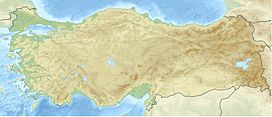- Cilician Gates
-
"Barbaron" redirects here. For the Armenian noble, see Constantine of Baberon.
Cilician Gates Gülek Boğazı 
Gülek Pass in TurkeyElevation 1,050 m (3,445 ft) [1] Traversed by O-21 E90 Location  Turkey, Mersin Province
Turkey, Mersin ProvinceRange Taurus Mountains Coordinates 37°19′40″N 34°47′40″E / 37.32778°N 34.79444°ECoordinates: 37°19′40″N 34°47′40″E / 37.32778°N 34.79444°E The Cilician Gates or Gülek Pass is a pass through the Taurus Mountains connecting the low plains of Cilicia to the Anatolian Plateau, by way of the narrow gorge of the Gökoluk River. Its highest elevation is about 1000m.[2]
The Cilician Gates have been a major commercial and military artery for millennia.[3] In the early 20th century, a narrow-gauge railway was built through them, and today, the Tarsus-Ankara Highway (E90, O-21) passes through them.
The southern end of the Cilician gates is about 44 km north of Tarsus and the northern end leads to Cappadocia.
Contents
History
Yumuktepe (modern Mersin), which guards the Adana side of the gateway, with 23 layers of occupation, is at 4,500 BCE, one of the oldest fortified settlements in the world. The ancient pathway was a track for mule caravans, not wheeled vehicles. In ancient history the Hittites, Greeks, Alexander the Great, the Romans, Mongols, and the Crusaders have all traveled this route during their campaigns. The Bible testifies that Saint Paul of Tarsus and Silas went this way as they went through Syria and Cilicia. The Galatians Speaks of the cities of Derbe, Lystra and Iconium - cities visited by Paul on his first journey (Acts 14; Gal. 1:2), with the purpose of strengthening their churches, at the beginning of the second preaching journey (Acts 15:40-41).
The distance from the Anatolian plateau to the Cilician plain is about 110 kilometres (68 mi). In ancient times this was a journey of nearly five days. Saint Paul spoke, according to the Bible, about being in "dangers from rivers" and "dangers from robbers" (2 Cor. 11:26). This may explain why at 4.500 BCE, at the South Eastern end of the Cilician Gates was one of the world's first existing fortresses (later Mersin). The Army of the Ten Thousand, Alexander the Great before the Battle of Issus, Paul of Tarsus on his way to the Galatians, and part of the army of the First Crusade all passed through the Cilician Gates, the site of the medieval fortress of Baberon (or Barbaron), then a stronghold of the medieval Armenian Principality of Cilicia.[4]
When German engineers were working on the railroad link between Haydarpaşa Terminal in Istanbul, at the shore of the Sea of Marmara and Baghdad, they were unable to follow the steep-pitched, narrow, and tightly winding ancient track through the pass. The series of viaducts and tunnels they built are among the marvels of railroad engineering. The route was opened in 1918; the narrow-gauge working line moved Ottoman troops and war material to the Mesopotamian front in the closing months of World War I.
See also
- Cilicia
- Cilicia (satrapy)
- Gülek
- Caspian Gates
References
- ^ "Mersin-Coğrafya" (in Turkish). Mersin Şehir Rehberi. Archived from the original on February 8, 2009. http://74.125.77.132/search?q=cache:XhF5E9JfyLYJ:www.mersin.sehirrehberi.web.tr/Default.asp%3Fid%3D2+g%C3%BClek+ge%C3%A7idi+rak%C4%B1m&hl=en&ct=clnk&cd=12. Retrieved March 1, 2009.
- ^ W.L. Williams, Armenia, p. 8-11, quoted in Josephus Nelson Larned, The new Larned History for ready reference, reading and research s.v. "Armenia" full text
- ^ William Mitchell Ramsay, The historical geography of Asia Minor, 1890, passim full text
- ^ Ghazarian, Jacob G. (2000). The Armenian Kingdom in Cilicia During the Crusades: The Integration of Cilician Armenians with the Latins, 1080-1393. Routledge. p. 122. ISBN 0700714189.
External links
Categories:- Ancient Cappadocia
- Cilicia
- Mountain passes of Turkey
- Mersin Province
- Mountains of Turkey
- History of Mersin Province
Wikimedia Foundation. 2010.

